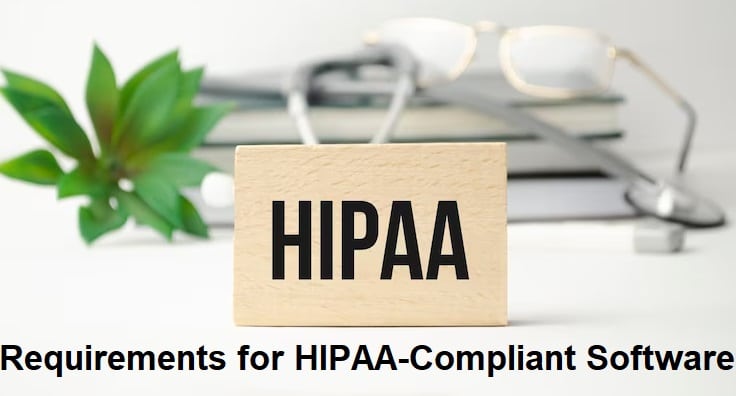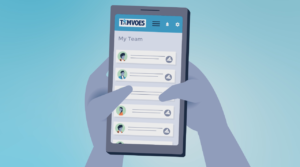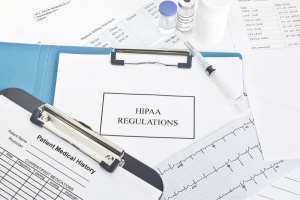Healthcare organizations must understand HIPAA-compliant software requirements to ensure their software solutions are 100% HIPAA-compliant.
Healthcare data is complex and diverse, scattered across multiple systems and departments. Protecting patient data is a major concern, and the Health Insurance Portability and Accountability Act (HIPAA) sets national standards to ensure its security and patient privacy.
This blog post will explain how your healthcare apps can meet HIPAA’s essential requirements. We will also discuss some common HIPAA violations and how to avoid them.
Requirements of HIPAA Compliance
HIPAA regulations exist to protect individuals’ sensitive health information and ensure that healthcare providers and other related entities do their utmost to preserve this information’s confidentiality, integrity, and availability.
Here’s an overview of the main rules that constitute HIPAA compliance requirements:
- The Privacy Rule: The HIPAA privacy rule provides the standards for protecting individuals’ health records and other identifiable health information. It sets limits and conditions on the uses and disclosures of such information without patient authorization.
- The Security Rule: The HIPAA security rule establishes the national standards to protect electronic personal health information that is created, received, used, or maintained. It requires appropriate administrative, physical, and technical safeguards to ensure electronic protected health information’s confidentiality, integrity, and security.
- The Breach Notification Rule: This rule mandates that covered entities and their business associates must provide notification following a breach of unsecured protected health information.
- The Enforcement Rule: This rule provides the penalties for violations of HIPAA rules and procedures for investigations and hearings for HIPAA violations.
- The Omnibus Rule: Implemented in 2013, this rule modified the HIPAA Privacy, Security, and Enforcement Rules to implement statutory amendments under the Health Information Technology for Economic and Clinical Health (HITECH) Act. It increased penalties for non-compliance, expanded rights to patients’ access to their health information, and extended full liability for breaches to business associates of healthcare providers.
Let’s talk about the essential requirements for HIPAA-compliant healthcare software application.
1. Implementing Secure Access Controls
It is critical to have procedures in place to authenticate and manage the access of your system users. This typically involves:
- Strong passwords
- Two-factor or multi-factor authentication
- Encryption of data both at rest and in transit
- Automatic logoff features
Additionally, your healthcare software should maintain a detailed log of all attempted and successful accesses and any modifications made to electronic health records or data.
2. Conducting HIPAA Risk Assessments
Risk assessments help your organization identify and address vulnerabilities in your security measures. These assessments should cover every system handling PHI and ePHI, including software, hardware, and human interactions.
They should evaluate whether current measures can protect against unauthorized data access, alteration, deletion, and disclosure threats.
Risk assessments aren’t a one-time event; they should be conducted periodically (at least once a year) and as new work practices are introduced or when significant system modifications are made.
For more information on how to conduct a comprehensive HIPAA risk assessment, check out this article.
3. Conducting Self-Audits
Self-audits are an essential internal process to ensure HIPAA compliance. These audits provide deeper insight into how PHI is used and disclosed within your organization and check the effectiveness of implemented security measures.
They can also help identify any discrepancies between your current practices and the requirements of HIPAA, which can inform future improvement plans.
4. Documenting Everything
Documentation isn’t limited to technical configurations but extends to all aspects of your compliance efforts.
This includes policies, procedures, employee training, risk assessments, business associate agreements, breach notification records, and any actions, activities, or assessments related to PHI.
HIPAA requires that this documentation be retained for at least six years from its creation or from the date it was last in effect, whichever is later.
5. Implementing Remediation Plans
Identifying vulnerabilities through risk assessments and internal audits is the first step – developing and implementing remediation plans to address these security weaknesses is critical to maintaining HIPAA compliance.
Remediation plans involve changes to policies, procedures, and systems to rectify identified weaknesses and increase the overall security of PHI. This could include new security measures, data encryption, software updates, workforce training, or changing business practices.
6. Ensuring Data Backup
All PHI should be backed up to recoverable and secure data storage, the cloud or a physical storage system.
Beyond this, organizations need to have procedures in place to restore any lost data in the event of an emergency or disaster, as well as a comprehensive disaster recovery plan that outlines how to maintain or quickly restore business processes in a crisis.
7. Assess Internal Policies Regularly
The rapidly evolving technology landscape and ever-present cyber threats necessitate regular internal policies and procedures assessment.
Businesses should comprehensively review all policies and procedures, including access controls, employee training, incident response, and contingency planning. Regular reviews can ensure these policies stay current and can adapt to new security challenges and advancements in technology.
8. Avoiding Shortcuts to Be HIPAA-Compliant
Taking shortcuts for HIPAA compliance can lead to gaps in compliance, leaving you vulnerable to data breaches and non-compliance penalties.
Therefore, a thorough, comprehensive approach to HIPAA compliance is necessary, involving ongoing risk assessments, regular staff training, and continuous review and improvement of processes.
9. Managing Business Associates
Business associates, or any third parties that handle PHI on behalf of your organization, must also be HIPAA compliant. This includes anyone from an electronic health record (EHR) provider to a billing company or a cloud service provider.
Covered entities must sign Business Associate Agreements (BAAs) with these associates to ensure they know their responsibilities to protect PHI. Furthermore, your organization should actively monitor these associates’ compliance efforts to ensure the continued safety of PHI.
10. Reporting Data Breaches
HIPAA requires organizations to report breaches to affected individuals, the Secretary of Health and Human Services, and in some cases, the media, within specific time frames.
Rapid, accurate, and thorough reporting can help mitigate potential damage and demonstrates your organization’s commitment to transparency and data security.
MedStack has a free HIPAA compliance checklist to help you build HIPAA-compliant medical software – Click here to get yours!
Consequences of Not Being Compliant With HIPAA
Not being compliant with HIPAA can have serious consequences for healthcare organizations and individuals involved.
Types of HIPAA Violations
HIPAA violations can result from a variety of scenarios, but they typically fall into one of four categories:
- Unintentional Negligence: This level of violation occurs when an entity doesn’t know and, by exercising reasonable diligence, would not have known that it violated a provision. This could include minor incidents, such as employees inadvertently accessing patient records or losing unencrypted devices containing protected health information (PHI).
- Reasonable Cause: This category refers to violations that occur due to circumstances that would make it unreasonable for the covered entity, despite exercising ordinary business care and prudence, to comply with the administrative simplification provision violated.
- Willful Neglect but Corrected: These are violations due to willful neglect of HIPAA rules, where the neglect is defined as “conscious, intentional failure or reckless indifference to the obligation to comply” with the requirement or prohibition, but the entity corrects the violation within 30 days of discovery.
- Willful Neglect Not Corrected: This is the most severe violation. It pertains to situations where willful neglect of HIPAA rules occurred, and the violation was not corrected on time. Penalties for this type of violation can be substantial and potentially include criminal charges.
Penalties for Civil Violations
Below are the penalties for civil violations:
| HIPAA Violation Type | Penalty Range | Annual Maximum for Repeat Violations |
| Unknowing | $100 – $50,000 per violation | $25,000 |
| Reasonable Cause | $1,000 – $50,000 per violation | $100,000 |
| Willful Neglect but Violation is Corrected Within the Required Period | $10,000 – $50,000 per violation | $250,000 |
| Willful Neglect and is Not Corrected Within Required Period | $50,000 per violation | $1.5 million |
Penalties for Criminal Violations
Criminal violations of HIPAA are handled by the Department of Justice (DOJ). There are different levels of severity for criminal violations.
| HIPAA Violation Type | Fine | Imprisonment |
| Knowingly Obtain or Disclose Individually Identifiable Health Information | Up to $50,000 | Up to 1 year |
| Offenses Committed Under False Pretenses | Up to $100,000 | Up to 5 years |
| Offenses Committed with the Intent to Sell, Transfer, or Use Individually Identifiable Health Information for Commercial Advantage, Personal Gain, or Malicious Harm | Up to $250,000 | Up to 10 years |
HIPAA compliance software can save you from these violations with fool-proof security controls and inheritable policies.
Most Common HIPAA Violations
It is important to be aware of the most common HIPAA violations to ensure compliance with the law. Here are the top HIPAA violations you should prioritize:
1. Impermissible Uses and Disclosures
Data suggests a significant concern within the healthcare services industry; in 2021, employees accounted for 39% of healthcare breaches, notably higher than the 18% in other industries.
Misconduct often arises from employees accessing medical information without appropriate clearance. Motives for such activities range from curiosity and spite to a misguided desire to assist friends or family.
Sometimes, healthcare employees may need to discuss specific patients’ diagnoses, treatment plans, or medications. However, these discussions must remain private. Conversations in public settings or within earshot of non-medical personnel can inadvertently violate a patient’s privacy.
Solution:
Employee training should clearly outline who has access to what information and unequivocally highlight the consequences of a violation. Through a blend of thorough staff training and robust access procedures, you can build a resilient safeguard against HIPAA violations.
2. Losing Non-Encrypted Devices
Often, electronic devices are taken outside the secure environment of healthcare facilities and left unattended in cars, hotel rooms, or even public areas, which makes them susceptible to theft.
The threat becomes significantly more severe when these devices lack password protection or encryption, leaving sensitive data like social security numbers, diagnoses, and medication information open to unauthorized access.
An incident at the Catholic Health Care Services of the Archdiocese of Philadelphia (CHCS) in 2016 illustrates the severity of this problem. An iPhone containing a considerable amount of ePHI was stolen. The device was neither password-protected nor encrypted, leaving 412 nursing home residents and their family members’ data vulnerable. The facility was fined $650,000 as a result.
Solution:
- Enforcing device encryption to protect health data in case of theft
- Stringent physical security rules and device sign-out policies
- Employee training on appropriate device handling and storage
- Using device tracking software to locate lost or stolen devices
- Prompt reporting of device theft
3. Improper Disposal of PHI and Medical Data
HIPAA compliance necessitates stringent protocols for PHI disposal to safeguard patients’ confidential data. From when PHI is created to when it’s no longer needed, the focus must remain on preserving its confidentiality and integrity.
It’s critical that healthcare providers thoroughly destroy or shred paper documents containing PHI, not merely discard them. Moreover, ePHI must be permanently deleted from all storage media, including local and portable hard drives.
Solution:
When retention periods for PHI have expired, the information must be permanently and securely destroyed by HIPAA guidelines. This could involve thorough shredding or pulping for paper records, while for ePHI, degaussing, secure wiping, or even physical destruction of the storage devices may be required.
4. Database Breaches
In 2021 alone, healthcare data breaches affected an alarming 50 million individuals, a significant 15% of the US population.
Such breaches expose sensitive Protected Health Information (PHI) like Social Security numbers, birth dates, addresses, and insurance details, making them a lucrative target for cybercriminals for a data breach.
Solution:
Proactive measures are crucial in eliminating such threats, including:
- Using HIPAA compliance software
- Maintaining up-to-date antivirus software on all devices storing ePHI
- Deploying robust firewalls while building HIPAA-compliant software
- Implementing unique, complex passwords that are frequently changed
5. Third-Party Disclosure of PHI
In the complex healthcare environment, many organizations collaborate with third-party entities, many of which gain access to PHI. According to HIPAA regulations, all entities handling PHI, including third-party contractors, must adhere to HIPAA standards.
Potential incidents involving third parties may still occur despite having a Business Associate Agreement (BAA). Violations happen for various reasons, such as unauthorized handling of medical contracts by off-site or regional departments, vendor transactions involving PHI, or the abrupt onboarding of business associates due to urgent requirements.
Solution:
Organizations should delegate the management of third-party contracts to a designated individual. This person should oversee the completion and compliance of the entire BAA process to prevent violations, which often stem from a lack of oversight or misunderstanding of HIPAA regulations.
Final Thoughts
It’s difficult to keep up with HIPAA’s ever-evolving requirements as healthcare software developers or a digital health company.
Luckily, you don’t have to navigate this journey alone. MedStack is here to simplify HIPAA compliance. We provide robust, intuitive solutions to help your healthcare organization meet and exceed HIPAA compliance requirements, safeguard patient data, and confidently achieve your healthcare mission.
Contact MedStack today to learn how we can streamline your compliance processes and safeguard your organization and health care providers from costly violations.
Let’s make healthcare safer together.





